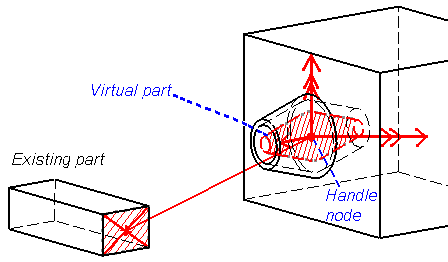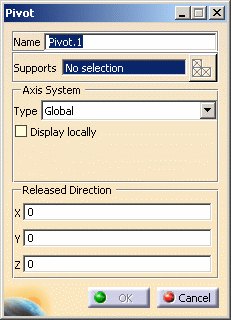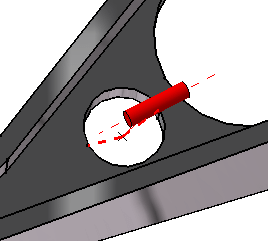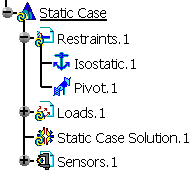This task shows how to create a Pivot on a virtual part.
Pivots are hinge (conical join) restraints applied to
handle points of virtual parts, which result in constraining the point to
rotate around a given axis. They can be viewed as particular cases of
general hinge joins, which allow a relative rotation between two points (in
the Pivot case, one of the two points is fixed, along with the pivot
axis).
Pivot objects belong to Restraints sets.

![]() means that there is no translation degree of freedom left in that
direction.
means that there is no translation degree of freedom left in that
direction.
![]() means that there is no rotation degree of freedom left in the direction.
means that there is no rotation degree of freedom left in the direction.
For the fixed point, the program automatically picks the handle of the virtual part. The user defines the pivot direction, and as a result the virtual part as a whole is allowed to rotate around an axis parallel to the pivot direction and passing through the fixed point.
When connected to deformable bodies, the virtual part will transmit the effect of the Pivot restraint collectively to the entire connected geometry.
Pivots can be applied to the following types of supports:
|
Geometrical Feature |
Mechanical Feature |
Analysis Feature |
||||
|
Spatial Groups |
Geometrical Groups |
Groups by Neighborhood |
Groups by Boundary |
Others |
||
|
Virtual Part |
||||||
To know more, refer to Authorized Supports.
Open the sample15.CATAnalysis document from the samples directory.
-
Go to View > Render Style > Customize View and make sure the Shading, Outlines and Materials options are active in the Custom View Modes dialog box.
-
Click Pivot
 in the Restraints toolbar.
in the Restraints toolbar.The Pivot dialog box appears.

To know more about the Select Mesh Part button, refer to Selecting Mesh Parts.
-
You can change the identifier of the Pivot by editing the Name field, if needed.
The Axis System Type combo box allows you to choose between Global and User-defined Axis systems for entering components of the pivot axis.
- Global: if you select the Global Axis system, the components of the pivot direction will be interpreted as relative to the fixed global rectangular coordinate system.
- User-defined: if you select a User-defined
Axis system, the components of the pivot direction will be
interpreted as relative to the specified rectangular coordinate
system.
To select a User-defined Axis system, you must activate an existing Axis by clicking it in the features tree. Its name will then be automatically displayed in the Current Axis field.
-
Set the Axis system.
-
In the X, Y, Z fields, enter the values corresponding to the components of the pivot direction relative to the selected Axis system.

- You can define the pivot direction by using the compass. The values in the X, Y, Z fields correspond to the direction components of the compass principal axis.
- You can modify the compass orientation either with the mouse or by editing the compass.
- By applying the compass to any part geometry, you can align the compass directions with the implicit axis directions of that geometry: drag the compass by handling the red square and drop it on the appropriate surface. The normal direction to this surface defines the new direction. Then, click on the Compass Direction button to take this new direction into account. You can now invert the direction if desired, by editing the values of the three components.
-
Select a virtual part.
A symbol representing the pivot direction is displayed on the virtual part.

-
Modify the pivot direction orientation.
The visualized Pivot symbol orientation is automatically updated to reflect the modifications of the compass principal direction.
-
Click OK.
A Pivot object appears in the specification tree under the active Restraints objects set.

- You can either select the virtual part support and then set the Pivot specifications, or set the Pivot specifications and then select the virtual part support.
- If several Analysis Cases have been defined in the Finite Element Model, you must activate a Restraints objects set by clicking it in the specification tree before creating a Pivot object.
- Restraints are required for Stress Analysis computations. They are optional for Modal Analysis computations (if not created, the program will compute vibration modes for the free, unrestrained part).
- Pivot objects can be edited by a double click on the corresponding object or icon in the features tree.
- Make sure you fixed all the global degrees of freedom of your assembly, otherwise a global singularity will be detected at the time of the Static Computation (such a model is unsolvable). To allow you to easily correct the model (Static Analysis Cases only), the singular displacement of the assembly will be simulated and visualized after computation.
The ELFINI Structural Analysis product offers the following additional functionalities:
-
Contextual menu on the restraint object:
- Restraint visualization on mesh:
the translation of the restraint specifications into solver
specifications can be visualized symbolically at the impacted mesh nodes,
provided the mesh has been previously generated using a mesh only
computation.
To know more, refer to Visualizing Restraints on Deformed Mesh.
- Restraint visualization on mesh:
the translation of the restraint specifications into solver
specifications can be visualized symbolically at the impacted mesh nodes,
provided the mesh has been previously generated using a mesh only
computation.
- Contextual menus on the restraints set:
- Generate Image: generates an image on the computed
restraints set (along with translating all user-defined restraints
specifications into explicit solver commands on mesh entities), by
generating symbols for the nodal restraints imposed by the restraints
sets. The image can be edited to include part or all of the
options available.
To know more, refer to Generating Images. - Report: the partial status and results of intermediate pre-processor computations are reported in HTML format. It represents a
subset of the global report capability and generates a partial report of
the restraints set computation.
To know more, refer to Generating Reports.
- Generate Image: generates an image on the computed
restraints set (along with translating all user-defined restraints
specifications into explicit solver commands on mesh entities), by
generating symbols for the nodal restraints imposed by the restraints
sets. The image can be edited to include part or all of the
options available.
![]()